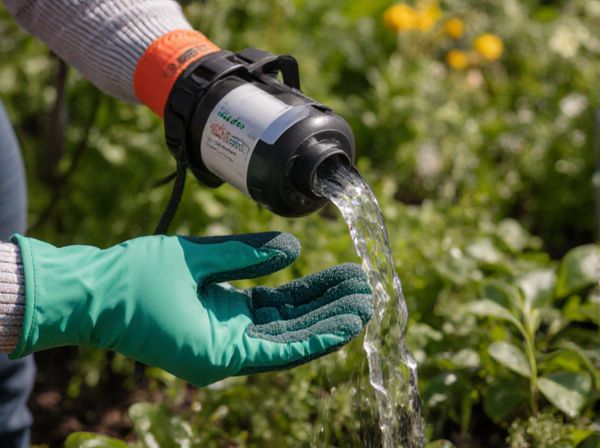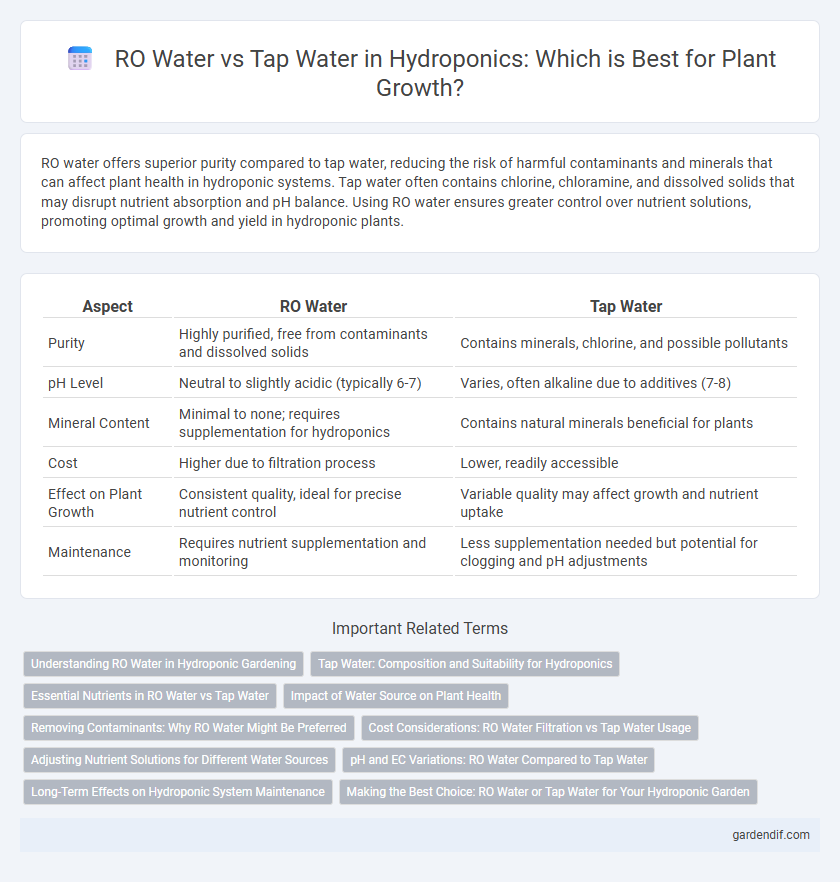
RO water vs Tap water Illustration
RO water offers superior purity compared to tap water, reducing the risk of harmful contaminants and minerals that can affect plant health in hydroponic systems. Tap water often contains chlorine, chloramine, and dissolved solids that may disrupt nutrient absorption and pH balance. Using RO water ensures greater control over nutrient solutions, promoting optimal growth and yield in hydroponic plants.
Table of Comparison
| Aspect | RO Water | Tap Water |
|---|---|---|
| Purity | Highly purified, free from contaminants and dissolved solids | Contains minerals, chlorine, and possible pollutants |
| pH Level | Neutral to slightly acidic (typically 6-7) | Varies, often alkaline due to additives (7-8) |
| Mineral Content | Minimal to none; requires supplementation for hydroponics | Contains natural minerals beneficial for plants |
| Cost | Higher due to filtration process | Lower, readily accessible |
| Effect on Plant Growth | Consistent quality, ideal for precise nutrient control | Variable quality may affect growth and nutrient uptake |
| Maintenance | Requires nutrient supplementation and monitoring | Less supplementation needed but potential for clogging and pH adjustments |
Understanding RO Water in Hydroponic Gardening
Reverse osmosis (RO) water in hydroponic gardening is highly purified, removing up to 99% of dissolved salts, minerals, and contaminants that can harm plant growth and nutrient uptake. Unlike tap water, which often contains chlorine, heavy metals, and variable pH levels, RO water provides a consistent, inert base allowing precise control over nutrient solutions. This purity enhances root health, prevents nutrient lockout, and optimizes overall plant development in hydroponic systems.
Tap Water: Composition and Suitability for Hydroponics
Tap water typically contains minerals and chlorine, which can affect nutrient absorption and plant health in hydroponic systems. Its variable pH levels and presence of contaminants require monitoring and sometimes treatment to optimize growing conditions. Understanding tap water composition is essential for maintaining a balanced nutrient solution conducive to hydroponic crop growth.
Essential Nutrients in RO Water vs Tap Water
RO water is stripped of most dissolved minerals and essential nutrients, requiring hydroponic growers to supplement with a complete nutrient solution to ensure optimal plant growth. Tap water naturally contains essential minerals like calcium, magnesium, and trace elements that contribute to plant health but may also introduce impurities and chlorine, which can affect nutrient uptake. Balancing nutrient concentration in hydroponics depends on the controlled addition of essential elements to RO water or managing the variability and potential contaminants present in tap water.
Impact of Water Source on Plant Health
Reverse osmosis (RO) water provides a purified, mineral-free environment that reduces the risk of contaminants and pathogens, promoting healthier hydroponic plant growth. Tap water often contains chlorine, chloramines, and various dissolved salts that can stress plant roots and alter nutrient uptake, potentially leading to nutrient imbalances or toxicity. Using RO water improves control over nutrient solutions, ensuring optimal pH levels and nutrient availability for robust plant development in hydroponic systems.
Removing Contaminants: Why RO Water Might Be Preferred
Reverse Osmosis (RO) water is preferred in hydroponics due to its superior ability to remove contaminants such as chlorine, heavy metals, and dissolved solids, which can harm plant growth and nutrient uptake. Unlike tap water, which often contains variable levels of minerals, salts, and chemical residues, RO water provides a clean, consistent baseline, preventing nutrient lockout and promoting healthier root development. Using RO water reduces the risk of introducing pathogens and chemical stress, optimizing the nutrient solution environment for maximum yield and plant health.
Cost Considerations: RO Water Filtration vs Tap Water Usage
RO water filtration systems involve upfront installation costs and ongoing expenses for membrane replacements and maintenance, often leading to higher long-term expenses compared to tap water usage. Tap water presents minimal direct costs but may require additional treatment to remove contaminants for hydroponic systems, potentially increasing overall expenses. Evaluating cost-effectiveness involves comparing initial investment, maintenance, and water quality impact on crop yield within hydroponic setups.
Adjusting Nutrient Solutions for Different Water Sources
Adjusting nutrient solutions for hydroponic systems requires precise management of RO water and tap water due to their distinct mineral content. RO water is nearly pure, necessitating the addition of essential macro- and micronutrients to achieve balanced nutrient concentrations for optimal plant growth. Tap water often contains variable levels of calcium, magnesium, and pH buffers, requiring tailored nutrient formulations and regular monitoring to prevent nutrient imbalances and ensure healthy crop development.
pH and EC Variations: RO Water Compared to Tap Water
RO water typically exhibits a neutral pH around 7 and very low electrical conductivity (EC), often below 50 uS/cm, indicating minimal dissolved minerals. In contrast, tap water pH varies widely, usually between 6.5 and 8.5, while EC can range from 200 to over 800 uS/cm depending on local water sources and treatment processes. These variations in pH and EC significantly impact nutrient availability and uptake in hydroponic systems, making RO water a preferred choice for controlled nutrient management.
Long-Term Effects on Hydroponic System Maintenance
Reverse Osmosis (RO) water significantly reduces mineral buildup and salt accumulation in hydroponic systems, lowering the frequency of cleaning and equipment replacement. Tap water often contains chlorine, chloramines, and dissolved minerals that can clog pumps and emitters, increasing maintenance demands and potentially harming plant roots over time. Consistent use of RO water enhances system longevity and stability by minimizing nutrient imbalances and preventing tubework corrosion.
Making the Best Choice: RO Water or Tap Water for Your Hydroponic Garden
RO water offers a purified option free from contaminants, heavy metals, and chlorine, which can harm sensitive hydroponic plants and disrupt nutrient uptake. Tap water's mineral content varies widely by location, often containing beneficial nutrients but sometimes including harmful chemicals or salts requiring filtration or treatment. Selecting the best water source depends on testing local tap water quality and balancing cost, plant health, and nutrient control to optimize hydroponic growth.
RO water vs Tap water Infographic

 gardendif.com
gardendif.com